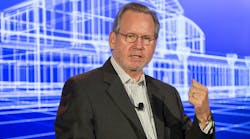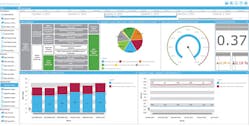It's the "equation we wake up with every day trying to solve" and Chris Curtis delivers it to the audience of Schneider Electric personnel, partners, customers and press at a recent Washington, D.C. meeting with a missionary zeal: ×2 vs ÷2.
The equation means that energy demand in the world will double by 2050 (×2), according to the International Energy Agency. In fact, demand for electricity is expected to double by 2030. But to avoid serious, perhaps catastrophic climate change damage, carbon dioxide emissions need to be cut by half by 2050 (÷2).
See Also: Lean Manufacturing Leadership Best Practices
As Schneider Electric (IW 1000/143) has grown through a series of acquisitions (Square D and APC in the U.S., for example), the French company has sought to shed its image as a holding company for hundreds of product brands and sharpen its identity as a global solution provider focused on energy management. "We need to be obsessed about the efficiency of our customers," says Chris Curtis, the president and CEO of Schneider Electric's North American business.
Curtis says individual brands such as Square D are not big enough by themselves to address these major issues. But he says Schneider Electric, a $31 billion business with 140,000 employees operating in more than 100 countries, offers the necessary scale and range of solutions to take on the energy challenge. The company offers energy management software and services and products ranging from electrical switches and circuit breakers to industrial automation controls for five end markets: buildings, utilities and infrastructure, industrial, data centers and residential.
It could hardly have picked a more significant issue to tackle. According to the Department of Energy, the U.S. spends about $200 billion a year to power commercial buildings and another $200 billion to power industrial facilities. These facilities account for half of the nation's energy usage and produce 40% of the carbon emissions.
The company is also focusing on the rapid urbanization going on around the world. By 2025, experts predict, two-thirds of the world's population will live in megacities (cities with populations over 10 million). The number of megacities will grow from 23 to 36, the United Nations forecasts, and the population in the top 600 cities in the world will grow by 500 million. But cities don't have the economic resources to build out and modernize the infrastructure needed to cope with these growing populations, says Curtis.
Energy management can make a significant contribution to either issue, Schneider maintains, by lowering operational costs up to 30% and freeing up scarce resources to pay for capital investments. Arguments for energy efficiency always come back to the point made by Curtis' boss, Jean-Pascal Tricoire, president and CEO of Schneider Electric: "The best watt is a negawatt -- the one you save or don't use!"
These problems will require innovative solutions, and Schneider Electric is devoting approximately 5% of sales to R&D activities. Curtis is putting the U.S. business squarely on the line for leading that innovation. "Our obligation is to be the most innovative entity in our company," he says.
Not surprisingly, Curtis has made talent recruitment and management a top priority. Schneider Electric is building strong relationships with a core set of universities, developing joint technology development relationships and sponsoring internships. "I want 75% of the university students we hire to come out of the internship programs," Curtis says, equating them to a "three-month interview" that provides the company with the most promising candidates. He is also emphasizing performance management to promote and develop the future leaders of the company and pursuing outside recruiting when it makes strategic sense.
Providing a Clearer Picture
Curtis says customers are asking Schneider Electric, "How do we make energy perform for us? How do we avoid heavy capital investments?" The answer leads, as in so many other areas these days, to the use of big data.
Companies have "tons of data but molehills of information," Curtis contends. The challenge as he sees it is to bring together often disparate information systems on various facets of operations, buildings, data centers and infrastructure and provide companies and governments with more visibility into the energy they are using and ways they can manage it more efficiently.
In 2009, Schneider Electric announced the development of EcoStruxure, a web-based software architecture designed to pull together information on power management, data centers, processes and machines, building controls and physical security. EcoStruxure takes multiple siloed systems and integrates them so that a company can have an enterprise-level, real-time view of data feeding in from its operations.
For individual industries and applications, Schneider Electric has rolled out StruxureWare software suites to help manage energy use across an organization. For example, the company in June introduced StruxureWare for Water for water and wastewater operations.
"StruxureWare for Water allows water managers to gather various data points about how they're using energy to move water, and how they can use that energy more efficiently," says Jokin Larrauri, Schneider Electric's vice president for water solutions. The program integrates process controls from electrical distribution and motor and pump control to chemical and biological treatment, safety and energy monitoring.
EPA estimates that municipal water systems lose an average of 16% of their volume, and Schneider Electric officials say some systems can lose up to a third. But many cities lack the money for expensive renovations of their systems. Through what it calls "performance contracting," Schneider Electric works with municipalities to employ the StruxureWare system and use the savings in energy and operations costs to fund infrastructure investments.
Abundance Won't Deter Efficiency
It might seem that as the U.S. begins to enjoy a bounty of domestic oil and natural gas from the shale revolution, preaching about energy efficiency would begin to fall on deaf ears. That's not a worry for Curtis.
He says a concern about sheer competitiveness should be enough to keep U.S. companies focused on energy efficiency.
"This country from an industrial-efficiency standpoint doesn't rank at the top when it comes to how much GDP output we create per dollar of energy we utilize," he notes, referencing a study by the American Council for an Energy-Efficient Economy that ranked the U.S. ninth out of the 12 largest global economies.
And, says Curtis, ignoring energy management would fly in the face of an uncertain economic recovery and questions over how long the recent energy boom will last.
Steve Wilhite, a senior vice president in Schneider Electric's Professional Services group, says low-hanging fruit in terms of energy savings is still abundantly available, and many times with no capital expenditure.
"We'll come in with a team and we'll find a lot of operational savings. In the last four years, we have been in over 1,000 facilities. On average, we find 8% to 10% savings with two-year paybacks or less," says Wilhite. In many cases, those savings come even after a plant has invested in more efficient lighting and other energy-savings steps. Some typical energy culprits include leaking compressed air, poor management of energy loads and having too many systems operating during off-production hours.
Like Curtis, Wilhite sees a strong continued push for sustainability and energy efficiency. He says that is particularly noticeable among large retail brands that are conscious of their public image, but there are also more industrial firms focused on this issue. One reason is that demand has not prompted the same kinds of investment in production as in more robust economic times.
"We have hit a unique circumstance here. We have an economy that is not growing all that fast," he says. "So that capital that exists in the manufacturing environment that is invested in energy [efficiency] provides pretty solid returns."
As large companies focus on energy management, there is a corresponding need for more visibility into energy use and cost across an enterprise. Wilhite says a common problem in industrial firms is that there is an energy-savings project or period of attention and then there is no effective monitoring. Over time, problems creep back in and the initial energy savings disappear.
Big data is presenting opportunities for companies to exert more flexibility and control over facility energy use and react more quickly to changes in energy demand. It will also allow them to interact with capacity constraints in the electrical grid system.
"How a customer reacts with the grid will become more and more important," Wilhite says.
Schneider Electric has put its own operations to the test regarding energy management. The company joined the Department of Energy's Better Buildings Challenge, which calls for a 25% energy-intensity improvement over 10 years.
In its first three years, Schneider has reduced its energy intensity by 15.6%, compared to the program's goal of 7.5%. The company has employed a variety of tools to reduce energy use, including building automation, energy-efficient lighting, automated lighting control, energy metering and remote monitoring. The firm has introduced variable-speed drives and installed renewable energy.
Shaping a Global Company
Schneider Electric is following a familiar path for companies growing out of acquisitions. It faces the challenges of maintaining the brand equity of lines such as Square D and APC while forging a common identity under its parent name. And with its increased size and global reach, the company wants to grow beyond simply supplying manufactured goods and more effectively address a broader range of issues faced by its customers.
One part of this strategy is to have its individual business units be accountable for end markets, not just accounts. An example, says Curtis, is that when Schneider's building business representatives meet with a client, they are responsible not only for presenting building management and security systems, but also products such as power management and backup power.
At the same time the company is forging a more unified identity, it is poised for additional growth. At press time, the company had confirmed that it was in early talks to acquire Invensys, the London-based technology firm, at a price of $5 billion. While Invensys is thought to have its most immediate impact on Schneider Electric's industrial business, Frost & Sullivan Industry Manager Konkana Khaud says Invensys' strong position in energy monitoring, controls and software would strengthen Schneider Electric's commercial and residential building energy management businesses. Khaud says the acquisition likely would also lead to bolstering the firm's data-center business and would position it for a greater role in the competitive lighting and energy/temperature controls market.





